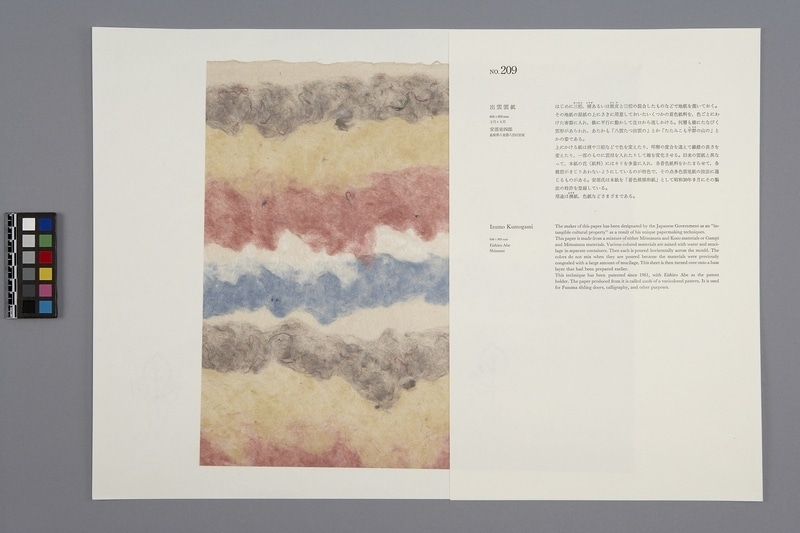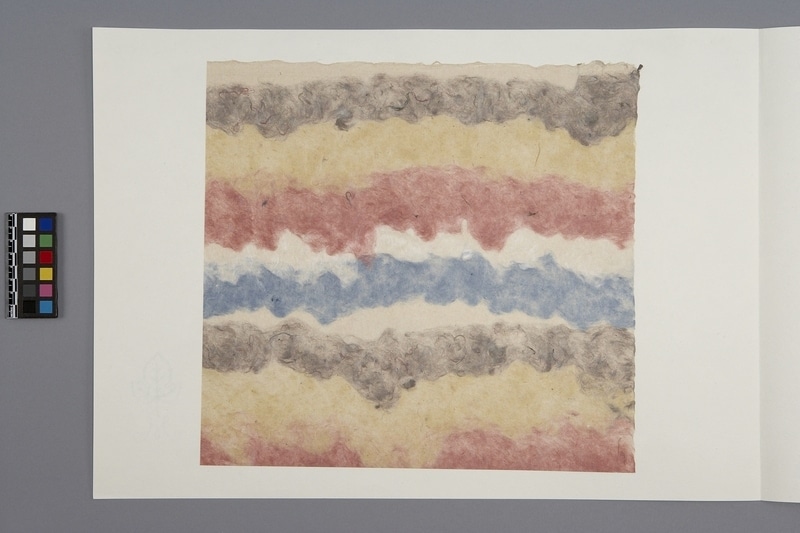Paper Item Number: Ed5.1754 from the MOA: University of British Columbia


Description
Washi sample mounted on white, labelled and folded paper with 3-pointed leaf above scrolled 'm' watermark. Sample is swirled fibre in single-coloured bands arranged lengthwise across and covering paper.
History Of Use
Papermaking originated on the Asian mainland and spread to Japan by 1500 years ago. For centuries Japan has produced the greatest quantity and variety of handmade paper or washi in the world. Traditionally, papermaking was a family or community enterprise which thrived in mountain farming communities where cold, pure water and wild bast fibre shrubs, such as mulberry, are plentiful. Washi is an important cultural symbol and holds a place in nearly every aspect of Japanese life. It is also a significant aspect of both Shinto and Buddhist rites and customs. Unryushi or 'cloud-surface' paper has many different varieties and is the most widely known type of sukimoyogami. Begun to be made in the 1920's, at close of Taisho Era, all paper at this time was pure white. Popularity for its expressiveness existed, being that just the hands and moulds were used to create designs. Later, multicoloured forms and hand-torn mulberry (kozo) developed. Used for fusuma sliding doors and calligraphy.
Cultural Context
sample
Narrative
This is part of the Tesukiwashi Taikan, a collection of handmade paper published, in an edition of 1000 copies, in Tokyo as a project to commemorate the centennial of Mainchi Newspapers and to preserve Japanese handmade paper. A collection on this scale had not been made before. This collection consists of 5 boxes of mounted and labelled samples with an explanatory book in 4 of the boxes. The text is in Japanese and, with less detail, in English. Compiled and edited by a special editorial staff of scholars. Published by the Mainchi Newspapers of Tokyo, Japan. Eishiro Abe has been designated as an intangible cultural property for his unique papermaking techniques.
Item History
- Made by Eishiro Abe (Maker) in Shimane, Japan before 1974
- Collected during 1977
- Owned by Yoshihisa Okamatsu before March 23, 1977
- Received from Yoshihisa Okamatsu (Donor) on March 23, 1977
What
- Name
- Paper
- Identification Number
- Ed5.1754
- Type of Item
- paper
- Overall
- height 51.4 cm, width 36.3 cm
Who
- Culture
- Japanese
- Creator
- Eishiro Abe (Maker)
- Previous Owner
- Yoshihisa Okamatsu
- Received from
- Yoshihisa Okamatsu (Donor)
Where
- Holding Institution
- MOA: University of British Columbia
- Made in
- Shimane, Japan
When
- Creation Date
- before 1974
- Collection Date
- during 1977
- Ownership Date
- before March 23, 1977
- Acquisition Date
- on March 23, 1977
Other
- Item Classes
- works on paper
- Condition
- good
- Accession Number
- 0369/0017 j